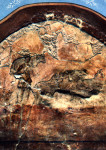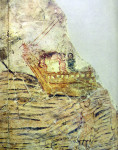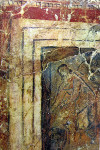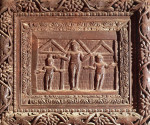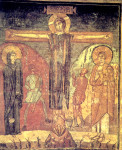
.
In the days before Yeshua’s Cat was written, before the wildfire scorched our land, I was exploring the changes that had carried humanity forward in time from the old Earth-based cultures of the Stone Age, through the violent upheavals of the late Bronze Age, and into the time of the Roman Empire. The planned lectures and workshops vanished in the wildfire’s smoke, but something else emerged. I realized that without the art of these ancient peoples we would understand almost nothing about them. So where was the art of the early church? How had my education in early Christian history managed to focus so entirely on words? As a result, I turned to the internet and the local university library and began to search for the visual language of the early Church. (In case you’d like to explore on your own, Picturing the Bible by Jeffrey Spier is a good place to start.)
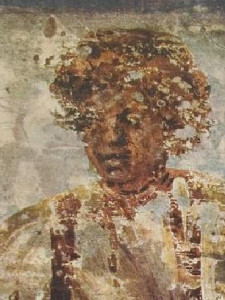
For much of the mid-20th century, common wisdom dismissed the “search for the historical Jesus” as a groundless hope, a fantasy for the unrealistic. But although we may never see a portrait of the flesh and blood man Jesus, the search has proved far from “groundless”: in our time the Earth herself has been yielding up the voices and visions of Jesus’ earliest followers with increasing frequency.
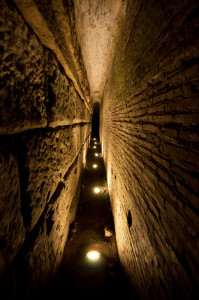
Anyone who visits Rome today steps into a buzzing archaeological hive. This in itself isn’t so strange; after all, many of Rome’s greatest attractions were literally unearthed from its ancient past. What fascinates me is how these ruins emerge. They aren’t turned up by a farmer’s plow, or weathered out of an eroding riverbank, but excavated from beneath the city’s basements. Apparently, Rome buried itself. And the same can be said of Jerusalem, or almost any other Mediterranean capital.* In Rome, for example, the twelfth-century Basilica of San Clemente that still stands today used the walls of the fourth-century San Clemente as foundations. This earlier church rose on top of a first-century mansion. Stairs of ever-increasing age, exposed in recent excavations, descend from the sunlit world down through the virtually intact fourth-century church and into the bowels of ancient Rome. There visitors can walk along a first-century Roman alleyway and explore a now-subterranean apartment building adjacent to the walls of the mansion used as an early Christian meeting place. And under it all lies the rubble of Rome’s great fire of 64 CE.

Canyons carved into the human past are literally opening at our feet along the Roman streets. We can almost believe we hear the slap of sandaled feet two thousand years dead. Anything seems possible. The past walks with us in ways we never imagined. Beneath the many strata of Roman civilization lies tuff, or hardened volcanic ash. Tuff is relatively soft until exposed to air, and is ideal for tunneling. This Roman bedrock made possible the creation of the lowest levels of all Roman ruins, the catacombs. As long as sufficient structural support was left in place, there was almost no limit to the number and extent of these labyrinthine burial chambers.

Although the most famous are Christian, catacombs existed before the early church period, and provided burial space well into the Common Era for those of many different religions. Their painted burial chambers offer us some of the earliest glimpses into the faith of Christian believers, perhaps even back to the middle of the first century.
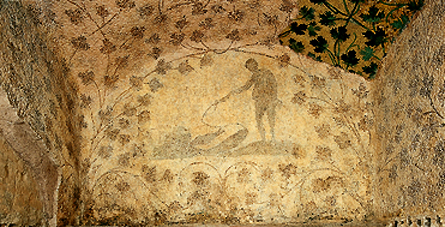
Visual art as a way of communicating our experience of the world is always personal, and far more powerful than words. Art strikes human depths directly. When a person chooses images to express the soul’s deepest yearnings in the face of death, non-essentials fall away. The heart chooses whatever makes life livable, hope possible. When we look at funerary art, we meet human beings as they turn their faces toward the mystery of life moving into death. This mystery is what we find in the catacombs.
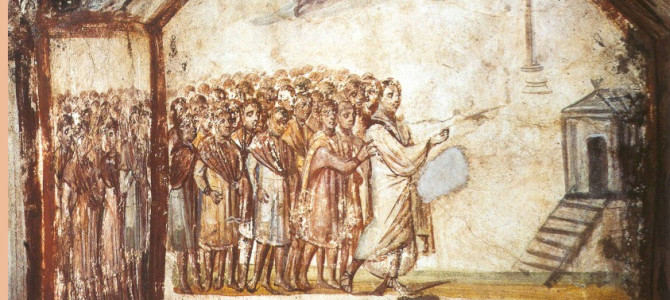
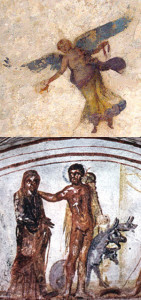
So why are these earliest of Christian testimonies so little known? Why have these painted gospels made so little impact on how Christians understand their faith today? Perhaps it is because our own worldviews get in the way. So an American tourist in Rome snaps a photo of Nike (Winged Victory), and calls her a Christian angel. Another sees a faded catacomb painting of Hercules with the three-headed dog Cerberus and identifies him as the Good Shepherd (with peculiar sheep). We see what we expect to see, squeezing everything into familiar molds. Or perhaps most people just haven’t had the chance yet to truly experience these painted gospels for themselves.
Early Christians chose dramatic images of Jesus and the Old Testament when they painted their tombs. Those appearing most frequently in the 3rd century and earlier are below:.
Jesus the Good Shepherd, who cared unceasingly for his flock:

Jesus the miracle-worker, who healed the sick, raised the dead, and controlled the elements:

Jesus the wise teacher:

Jonah’s sojourn in and emergence from the fish’s belly:
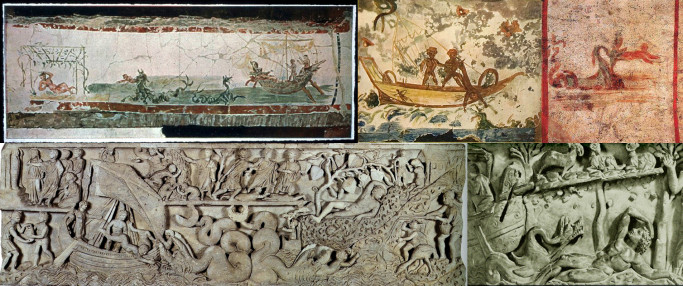
Daniel’s deliverance from the lions:

The three young men protected from the fiery furnace:

Early Christians also painted images of themselves on tomb walls, using two motifs more often than others: women and men with arms raised in prayer and praise; and small groups of Christians gathered around shared ritual meals.

The paintings in the house church at Dura Europos in Syria (dating from about 230-250 CE) are the only Christian images of similar age that have been discovered. The paintings there depict the good shepherd, Jesus’ miracles, the Samaritan woman at the well, and the women at the tomb, as well as Old Testament scenes. Also like the catacombs, they portrayed contemporary believers in positions of praise (orants).
No crucifixes, no suffering martyrs, no images of sacrifice appeared in the early years. These came at least 500 years later, with the developing doctrines of the church.
But what does all this have to do with people like us, living two thousand years later? What impact might it have? Let me paint you a picture with words.
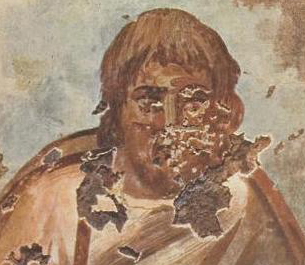
The Christian faith whispering from the dark walls of the catacombs shows us a young man of their own culture–robed, beardless, often holding a wand in his hand–reaching out with compassion and power to touch and heal the human pain around him. He stops the flow of menstrual blood that has made a woman ritually unclean for years. He commands death to release the dead Lazarus, and death yields to him. He sits as a teacher in a circle of disciples, speaking words of life. A strong man with bare legs, he stands among a flock of sheep, carrying a lamb across his shoulders. He betrays no weariness or impatience, only watchful care.
The faith pictured here is in a loving, powerful, and wise man sent from God to point the way and guide his people. They relied on his healing power, his love, and his commitment to their well-being. His God-given power was stronger than death, stronger than the destructive powers of nature, and stronger than human malice.
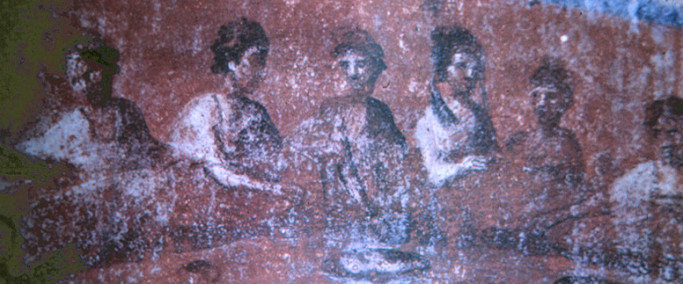
The believers in these painted gospels were neither theologically complex nor concerned with church structure. Women appeared in positions of leadership as often as did men. No canon of scripture had yet been established, although Paul’s letters were circulating among believers by the 50’s–when there were already growing Christian communities in Rome. Church hierarchy was only a spreading shadow on the horizon, and authority was fluid. What we now consider to be the four gospels were written between 70 and 100 CE, and did not become authoritative until much later. Communities of Christians followed their own personal experience and oral traditions, and suffered at the whim of Roman emperors.
By the third and fourth centuries, the increasingly hierarchical church forcibly silenced dissenting voices. Orthodoxy narrowed to a fine line. A few men concentrated all the power in their own hands. Congregations became sheep in ways they had never anticipated in the early years, and their shepherds were not always good. Too often fear, shame, and guilt discouraged the sheep from straying. Bloody sacrifice–Jesus’ own, and that of the martyrs–became a cornerstone of church doctrine where it had never been before. Bishops formulated creeds, damning those who did not confess Jesus in precisely their words–along with all followers of other faiths. The groundwork was laid for the Crusades and the Inquisition.

Like the Romans buried Rome, the church buried itself. But unlike Rome, what the church buried they rarely considered fit to use for new foundations. Whether these developments, and those that have followed in the centuries since, have anything at all to do with the message of Jesus of Nazareth is a question more and more people are asking today. In the end each of us may need to dig through the rubble of time and consciousness to find our own buried treasure. But one thing seems clear: the treasure is there. Perhaps our perceptions are at fault.
.
.
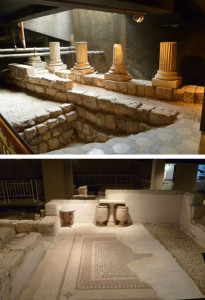
* The Wohl Museum of Archaeology in Jerusalem has excavated similar subterranean houses of the Herodian period from the hillside overlooking the Temple Mount. Although currently the museum has no website of its own, many pictures of their discoveries are available online . . . .
.
.

